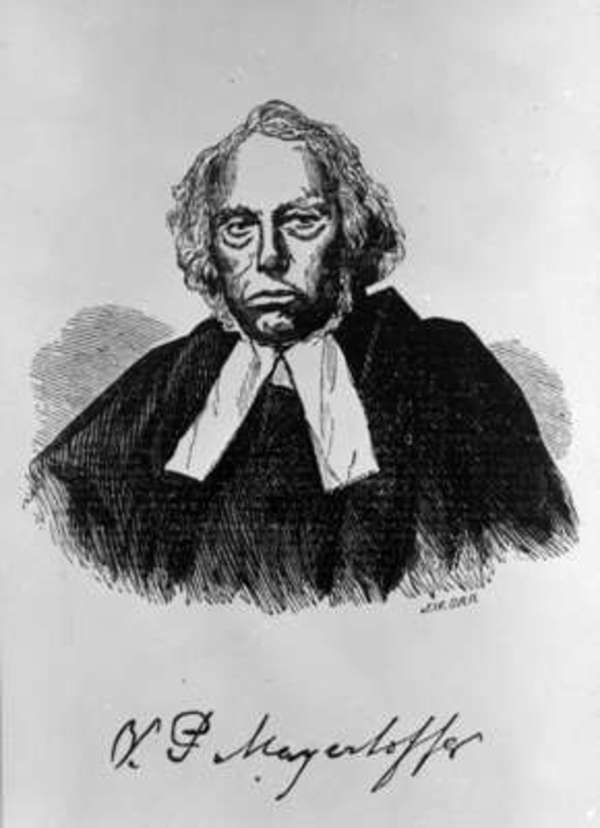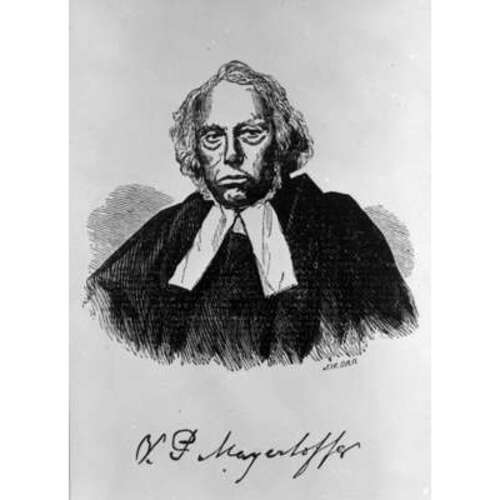
Source: Link
MAYERHOFFER, VINCENT PHILIP (baptized Vincent Ferrer), Church of England clergyman; b. 22 Jan. 1784 in Raab (Györ, Hungary), eldest child of Michael Mayerhoffer and Catharina Lublé (Lliebb); m. 27 Aug. 1820 Caroline Stahl, and they had nine children; d. 15 Jan. 1859 in Whitby, Upper Canada.
Vincent Philip Mayerhoffer had an exotic early life that intrigued those who later learned of it. According to his autobiography, he was born to Roman Catholic parents and educated at the normal school and the gymnasium in Raab. After the death of his father, a city senator, Vincent was sent at age 13 to the gymnasium run by the Piarist order at Colocza (Kalocsa, Hungary). Financial problems, however, eventually forced Vincent’s mother to apprentice him with a grocer in Pesth (Budapest) where he remained until difficulties with his master led him to move to Baja (Hungary) in September 1803 and become a baker’s apprentice. But Mayerhoffer was encouraged by a former teacher to return to Colocza, and after a year he decided to enter the Franciscan novitiate at Bàcs (Bač, Yugoslavia) and seek ordination despite his mother’s opposition. In February 1807 he sang his first high mass in Buda (Budapest), having received all seven ecclesiastical orders up to deacon and priest.
Following two curacies, Mayerhoffer became garrison chaplain at Peterwardein (Petrovaradin, Yugoslavia) and then, on 16 Oct. 1812, he was appointed chaplain of the 60th Infantry Regiment in the Austrian army. The following August he was captured by Napoleon’s troops, only to escape at Mainz (Federal Republic of Germany) in January 1814 and rejoin the 60th to see service in France, Italy, and Switzerland. Mayerhoffer left the army on 31 Oct. 1816 and returned to parochial duties, serving at Klingenmünster (Federal Republic of Germany). In 1819 he immigrated to North America and was appointed a missionary in Pennsylvania but, after harrowing disputes with the Jesuits at Conewego, described in his autobiography, Mayerhoffer, long disillusioned with Roman Catholicism, left the church on 20 March 1820. Although apparently without formal training, he opened in partnership a drug store in York, Pa, and “managed to pick up a living as a doctor.” Believing celibacy a “hellish invention,” he also married. After a two-year study of the Bible for guidance, Mayerhoffer decided to join “the German Reformed Church in Pennsylvania.” In 1826 he moved to Buffalo, N.Y., to preach in German to four congregations, including one across the border in Upper Canada “on the Limestone Ridges” in Bertie Township.
Mayerhoffer was becoming convinced, however, that episcopalianism was more apostolic in doctrine and government than the Protestant denomination with which he was affiliated. Since his English was poor, he wrote in Latin to Anglican bishop Charles James Stewart* of Quebec requesting reception as a clergyman. Shortly after examination by the bishop on 14 June 1829 at York (Toronto), he was sent as a missionary to three German-speaking congregations north of the town in the townships of Markham and Vaughan. Unable to find a Lutheran replacement for their minister, who was on the point of retirement, these congregations had sought the aid of York’s Anglican archdeacon, John Strachan*; after a few months Strachan considered that Mayerhoffer had begun “very successfully” in his new position. The peace and harmony that at first prevailed afforded Mayerhoffer the leisure to employ his talents in supplementing his meagre stipend; an advertisement appeared in the newspapers in 1832 for his newly invented “Wonder Salve” which “ought to be kept in every house, first for its inestimable goodness, and second because the [medicine] the older it gets the better it is.”
Though there is a local tradition that Mayerhoffer allowed his parishioners to believe he was a Lutheran minister, he does not, in fact, appear to have disguised his Anglican convictions. There was potential for trouble, however, since the original land deed of St Philip’s, Markham, stated that if ten years ever passed without a Lutheran pastor the property would be conveyed to the Church of England automatically. Furthermore, on 21 Jan. 1836 Mayerhoffer was among those Anglican clergy of the province granted a rectory by Lieutenant Governor Sir John Colborne*. The Colborne rectories infuriated those hostile to the concept of an established church and helped contribute to the political controversies about to engulf Upper Canada. These controversies were reflected in the developing split between reformers and tories among the congregations of Mayerhoffer, who was strongly opposed to William Lyon Mackenzie*. A meeting of Markham Lutherans in April 1837 resolved that since Mayerhoffer had “interfered in politics and other party proceedings” he should be removed and a Lutheran preacher found. On 4 May he was locked out of St Philip’s; nine days later, on the advice of Attorney General Christopher Alexander Hagerman*, he broke the locks and entered the church. The doors were locked and the locks broken repeatedly and then Mackenzie’s supporters placed a sentry beside the church door. The guard was driven away in December, after the abortive rebellion, by Orangemen who accompanied “old Tory Mayerhoffer” back into the church. In 1839 a majority of the Lutheran trustees commenced legal proceedings. According to Mayerhoffer, the Court of Queen’s Bench granted them possession three months before he could complete a ten-year ministry, though in fact it was not until 1843 that the Lutherans received the deed to St Philip’s. Since flaws were also judged to exist in the Church of England’s title to the lots of his other churches, he lost them as well; as he later recalled, “In this calamity I preached in schools and private houses.” With land and money donated by his Anglican supporters, Mayerhoffer built St Stephen’s in Vaughan and then St Philip’s Church in Markham, across the street from its Lutheran namesake.
These embroilments embarrassed Bishop Strachan, who reported in March 1841 to the Society for the Propagation of the Gospel that Mayerhoffer, having fallen off his horse and ruptured himself, ought to be pensioned off. “He should never have been received into our Church,” he added. Mayerhoffer, although still energetic, was less useful as a travelling missionary. Personal antipathy, however, appears to have figured in Strachan’s continued search to find a pension for Mayerhoffer, who “tho’ a moral & well meaning man is not in manners or qualifications calculated to build up the Church.” He considered Mayerhoffer an “eye-sore and a great encumbrance.”
By 1843 Mayerhoffer was working on a second church at Markham, in the village, where he was inducted by Archdeacon Alexander Neil Bethune* in the autumn of 1847. But the following year a replacement was found for Mayerhoffer and after some delays he was superannuated on 1 Jan. 1849, moving thereafter to Toronto with his family. In 1853 he took charge of a congregation in Perrytown but relinquished his post the following year, pleading ill health yet also under pressure from Strachan for being implicated in a bigamy case. Informed that never again should he function as a clergyman, he retired to Whitby where he finished his autobiography, appending a lengthy diatribe against the “putrid carcase” of Roman Catholicism. He died on 15 Jan. 1859 and was buried in the cemetery of St John’s, Whitby, with full masonic honours. His fellow Anglican clergyman Henry Scadding* described Mayerhoffer as having “strongly marked and peculiar, perhaps Mongolian” features and characterized him as “a man of energy to the last: ever cheerful in spirit, and abounding in anecdotes, personal or otherwise.”
Vincent Philip Mayerhoffer is the author of Twelve years a Roman Catholic priest, or, the autobiography of the Rev. V. P. Mayerhoffer, M.A., late military chaplain to the Austrian army, and grand chaplain of the orders of freemasons and Orangemen, in Canada, B.N.A., containing an account of his career as military chaplain, monk of the order of St. Francis, and clergyman of the Church of England in Vaughan, Markham and Whitby, C.W. (Toronto, 1861).
AO, MS 35; MS 199, M. S. Gapper O’Brien, diaries; MU 2818. Österreichische Staatsarchiv-Kriegsarchiv (Vienna), “Schematismus der k.k. Militärgeistlichkeit,” I: 99; Standestabellen des Infanterie-regiment 60, 1812: X; 1816: XI. PAC, RG 5, A1: 71036–40, 78344–47, 87623–25, 96875–82, 97031–42, 112017–20. PRO, CO 42/431: 329–31. USPG, C/CAN/folders 482a, 519; Journal of SPG, 39: 216–18; 40: 92–94. York County, Hist. Soc. (York, Pa.), “The registers of the First Moravian Congregation, York, Pennsylvania, 1751–1899,” trans. H. J. Young (typescript, 1938), book ii: 9. Whitby Chronicle (Whitby, [Ont.]), 27 Jan. 1859. J. L. H. Henderson, “John Strachan as bishop, 1839–1867” (dd thesis, General Synod of Canada (Toronto), Anglican Church of Canada, 1955). Historical sketch of Markham Township, 1793–1950; centennial celebration of municipal government, 1850–1950 ([Markham, Ont., 1950]). Markham, 1793–1900, ed. Isabel Champion (Markham, 1979). Millman, Life of Charles James Stewart. G. E. Reaman, A history of Vaughan Township; two centuries of life in the township (Vaughan, Ont., 1971). Scadding, Toronto of old (1873), 454–56. M. C. Keffer, “The early days of Zion Evangelical Lutheran Church, founded 1806 at Sherwood, York County,” York Pioneer (Toronto), 1960: 12–21. J. J. Talman, “From Moscow to Whitby, the romantic career of the first rector of Markham and Vaughan,” Canadian Churchman (Toronto), 4 March 1937: 133.
Cite This Article
Christopher Fergus Headon, “MAYERHOFFER, VINCENT PHILIP (baptized Vincent Ferrer),” in Dictionary of Canadian Biography, vol. 8, University of Toronto/Université Laval, 2003–, accessed January 5, 2026, https://www.biographi.ca/en/bio/mayerhoffer_vincent_philip_8E.html.
The citation above shows the format for footnotes and endnotes according to the Chicago manual of style (16th edition). Information to be used in other citation formats:
| Permalink: | https://www.biographi.ca/en/bio/mayerhoffer_vincent_philip_8E.html |
| Author of Article: | Christopher Fergus Headon |
| Title of Article: | MAYERHOFFER, VINCENT PHILIP (baptized Vincent Ferrer) |
| Publication Name: | Dictionary of Canadian Biography, vol. 8 |
| Publisher: | University of Toronto/Université Laval |
| Year of publication: | 1985 |
| Year of revision: | 1985 |
| Access Date: | January 5, 2026 |



